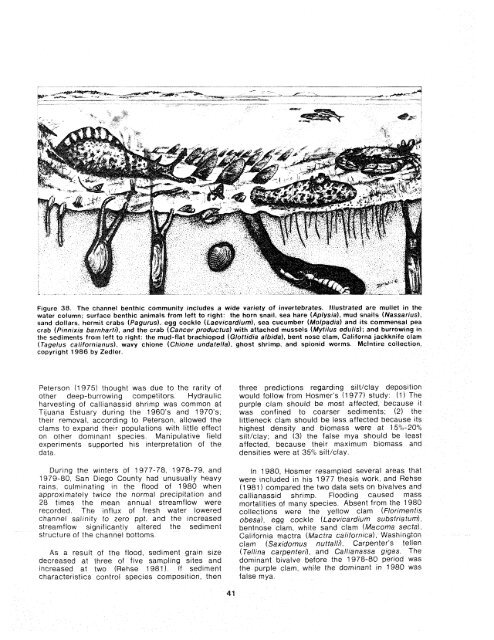The Ecology of Tijuana Estuary, California: An Estuarine Profile
The Ecology of Tijuana Estuary, California: An Estuarine Profile
The Ecology of Tijuana Estuary, California: An Estuarine Profile
You also want an ePaper? Increase the reach of your titles
YUMPU automatically turns print PDFs into web optimized ePapers that Google loves.
Figure 38. <strong>The</strong> channel benthic community includes a wide variety <strong>of</strong> invertebrates. Illustrated are muilet in the<br />
water column; surface benthic animals from left to right: the horn snail, sea hare (Aplysia), mud snails (Nassarius),<br />
sand dollars, hermit crabs (Pagurus), egg cockle (Laev~cardium), sea cucumber (Molpadia) and its commensal pea<br />
crab (Pinnixla barnhart!), and the crab (Cancer productus) with attached mussels (Mytilus edulis); and burrowing in<br />
the sediments from left to right: the mud-flat brachiopod (Glottidia aibrda), bent nose clam, Californa jackknife clam<br />
(Tagelus caltforntanus), wavy chione (Chtone undatella), ghost shrimp, and spionid worms. Mclntire collection,<br />
copyright 1986 by Zedler.<br />
Peterson (19751 thought was due to the rarity <strong>of</strong><br />
other deep-burrowing competitors. Hydraulic<br />
harvesting <strong>of</strong> callianassid shrimp was common at<br />
<strong>Tijuana</strong> <strong>Estuary</strong> during the 1960's and 1970's;<br />
their removal, according to Peterson, allowed the<br />
clams to expand their populations with little effect<br />
on other dominant species. Manipulative field<br />
experiments supported his interpretation <strong>of</strong> the<br />
data.<br />
During the winters <strong>of</strong> 1977-78, 1978-79, and<br />
1979-80, San Dtego County had unusually heavy<br />
rains, culm~nat~ng In the flood <strong>of</strong> 1980 when<br />
approximately tw~ce the normal precipitatron and<br />
28 times the mean annual streamflow were<br />
recorded <strong>The</strong> Influx <strong>of</strong> fresh water lowered<br />
channel sal~ntty to zero ppt, and the increased<br />
streamflow s~gn~f~cantly altered the sed~ment<br />
structure <strong>of</strong> the channel bottoms<br />
As a result <strong>of</strong> the flood, sedlment gratn size<br />
decreased at three <strong>of</strong> flve sampllng srtes and<br />
increased at two (Rehse 1981) If sed~ment<br />
character~st~cs control specfes cornposit~on, then<br />
three predicttons regarding s~lt/clay deposition<br />
would follow from Hosmer's (1977) study (1 <strong>The</strong><br />
purple clam should be most affected, because it<br />
was conflned to coarser sed~ments, (2) the<br />
littleneck clam should be less affected because IPS<br />
highest denslty and bromass were at 15%-20%<br />
siltlclay, and (3) the false mya should be least<br />
affected, because their maxlmum b~omass and<br />
densit~es were at 35% siit/clay<br />
In 1980, Hosmer resampled several areas that<br />
were Included In h ~s 1977 thesis work, and Rehse<br />
(1981 compared the two data sets on btvalves and<br />
callianasstd shrimp Flooding caused mass<br />
mortalities <strong>of</strong> many species Absent from the 1980<br />
collect~ons were the yellow clam (Nonmenbs<br />
obesa), egg cockle (Laevtcard~um substrtatum),<br />
bentnose clam, whlte sand clam (Macoma secta).<br />
<strong>California</strong> mactra (Macfra cairlornrcai, Washington<br />
clam (Saxidomus nuttali/], Carpenter's tellen<br />
(Tell~na carpenter/?, and Calitanassa grgas <strong>The</strong><br />
dominant b~valve before the 1978-80 period was<br />
the purple clam, while the dominant in 1980 was<br />
false rnya<br />
4 1

















